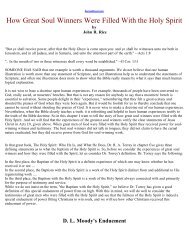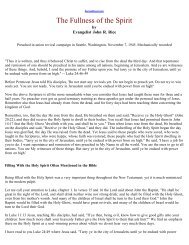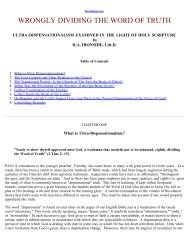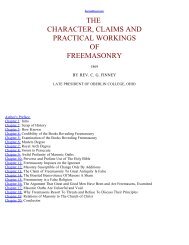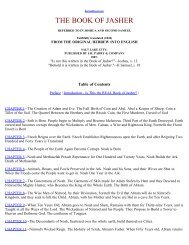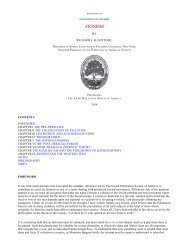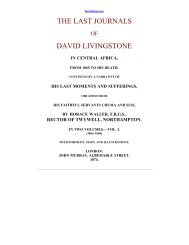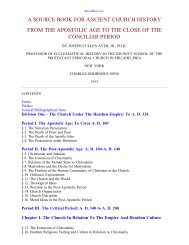Legends of Babylon and Egypt in Relation to Hebrew Tradition.pdf
Legends of Babylon and Egypt in Relation to Hebrew Tradition.pdf
Legends of Babylon and Egypt in Relation to Hebrew Tradition.pdf
Create successful ePaper yourself
Turn your PDF publications into a flip-book with our unique Google optimized e-Paper software.
God <strong>of</strong> Wisdom, he is not only the teacher but the crea<strong>to</strong>r <strong>of</strong> those deities who were patrons <strong>of</strong> man's own constructive<br />
work. From such evidence we may <strong>in</strong>fer that <strong>in</strong> his temple at Eridu, now covered by the mounds <strong>of</strong> Abu Shahra<strong>in</strong> <strong>in</strong><br />
the extreme south <strong>of</strong> <strong>Babylon</strong>ia, <strong>and</strong> regarded <strong>in</strong> early Sumerian tradition as the first city <strong>in</strong> the world, Enki himself<br />
was once celebrated as the sole crea<strong>to</strong>r <strong>of</strong> the universe.<br />
The comb<strong>in</strong>ation <strong>of</strong> the three gods Anu, Enlil, <strong>and</strong> Enki, is persistent <strong>in</strong> the tradition; for not only were they the great<br />
gods <strong>of</strong> the universe, represent<strong>in</strong>g respectively heaven, earth, <strong>and</strong> the watery abyss, but they later shared the heavenly<br />
sphere between them. It is <strong>in</strong> their astrological character that we f<strong>in</strong>d them aga<strong>in</strong> <strong>in</strong> creative activity, though without the<br />
co-operation <strong>of</strong> any goddess, when they appear as crea<strong>to</strong>rs <strong>of</strong> the great light-gods <strong>and</strong> as founders <strong>of</strong> time divisions,<br />
the day <strong>and</strong> the month. This Sumerian myth, though it reaches us only <strong>in</strong> an extract or summary <strong>in</strong> a Neo-<strong>Babylon</strong>ian<br />
schoolboy's exercise,[1] may well date from a comparatively early period, but probably from a time when the "Ways"<br />
<strong>of</strong> Anu, Enlil, <strong>and</strong> Enki had already been fixed <strong>in</strong> heaven <strong>and</strong> their later astrological characters had crystallized.<br />
[1] See /The Seven Tablets <strong>of</strong> Creation/, Vol. I, pp. 124 ff. The tablet gives extracts from two very similar Sumerian<br />
<strong>and</strong> Semitic texts. In both <strong>of</strong> them Anu, Enlil, <strong>and</strong> Enki appear as crea<strong>to</strong>rs "through their sure counsel". In the<br />
Sumerian extract they create the Moon <strong>and</strong> orda<strong>in</strong> its monthly course, while <strong>in</strong> the Semitic text, after establish<strong>in</strong>g<br />
heaven <strong>and</strong> earth, they create <strong>in</strong> addition <strong>to</strong> the New Moon the bright Day, so that "men beheld the Sun-god <strong>in</strong> the<br />
Gate <strong>of</strong> his go<strong>in</strong>g forth".<br />
The idea that a goddess should take part with a god <strong>in</strong> man's creation is already a familiar feature <strong>of</strong> <strong>Babylon</strong>ian<br />
mythology. Thus the goddess Aruru, <strong>in</strong> co-operation with Marduk, might be credited with the creation <strong>of</strong> the human<br />
race,[1] as she might also be pictured creat<strong>in</strong>g on her own <strong>in</strong>itiative an <strong>in</strong>dividual hero such as Enkidu <strong>of</strong> the<br />
Gilgamesh Epic. The /rôle/ <strong>of</strong> mother <strong>of</strong> mank<strong>in</strong>d was also shared, as we have seen, by the Semitic Ishtar. And though<br />
the old Sumerian goddess, N<strong>in</strong>kharsagga, the "Lady <strong>of</strong> the Mounta<strong>in</strong>s", appears <strong>in</strong> our Sumerian text for the first time<br />
<strong>in</strong> the character <strong>of</strong> creatress, some <strong>of</strong> the titles we know she enjoyed, under her synonyms <strong>in</strong> the great God List <strong>of</strong><br />
<strong>Babylon</strong>ia, already reflected her cosmic activities.[2] For she was known as<br />
"The Builder <strong>of</strong> that which has Breath", "The Carpenter <strong>of</strong> Mank<strong>in</strong>d", "The Carpenter <strong>of</strong> the Heart", "The Coppersmith<br />
<strong>of</strong> the Gods", "The Coppersmith <strong>of</strong> the L<strong>and</strong>", <strong>and</strong> "The Lady Potter".<br />
[1] Op. cit., p. 134 f.<br />
[2] Cf. /Cun. Texts <strong>in</strong> the Brit. Mus./, Pt. XXIV, pl. 12, ll. 32, 26, 27, 25, 24, 23, <strong>and</strong> Poebel, /Hist. Texts/, p. 34.<br />
In the myth we are not <strong>to</strong>ld her method <strong>of</strong> creation, but from the above titles it is clear that <strong>in</strong> her own cycle <strong>of</strong><br />
tradition N<strong>in</strong>khasagga was conceived as fashion<strong>in</strong>g men not only from clay but also from wood, <strong>and</strong> perhaps as<br />
employ<strong>in</strong>g metal for the manufacture <strong>of</strong> her other works <strong>of</strong> creation. Moreover, <strong>in</strong> the great God List, where she is<br />
referred <strong>to</strong> under her title Makh, N<strong>in</strong>khasagga is associated with Anu, Enlil, <strong>and</strong> Enki; she there appears, with her<br />
dependent deities, after Enlil <strong>and</strong> before Enki. We thus have def<strong>in</strong>ite pro<strong>of</strong> that her association with the three chief<br />
Sumerian gods was widely recognized <strong>in</strong> the early Sumerian period <strong>and</strong> dictated her position <strong>in</strong> the classified pantheon<br />
<strong>of</strong> <strong>Babylon</strong>ia. Apart from this evidence, the important rank assigned her <strong>in</strong> the his<strong>to</strong>rical <strong>and</strong> legal records <strong>and</strong> <strong>in</strong><br />
votive <strong>in</strong>scriptions,[1] especially <strong>in</strong> the early period <strong>and</strong> <strong>in</strong> Southern <strong>Babylon</strong>ia, accords fully with the part she here<br />
plays <strong>in</strong> the Sumerian Creation myth. Eannatum <strong>and</strong> Gudea <strong>of</strong> Lagash both place her immediately after Anu <strong>and</strong> Enlil,<br />
giv<strong>in</strong>g her precedence over Enki; <strong>and</strong> even <strong>in</strong> the Kassite Kudurru <strong>in</strong>scriptions <strong>of</strong> the thirteenth <strong>and</strong> twelfth centuries,<br />
where she is referred <strong>to</strong>, she takes rank after Enki <strong>and</strong> before the other gods. In Sumer she was known as "the Mother<br />
<strong>of</strong> the Gods", <strong>and</strong> she was credited with the power <strong>of</strong> transferr<strong>in</strong>g the k<strong>in</strong>gdom <strong>and</strong> royal <strong>in</strong>signia from one k<strong>in</strong>g <strong>to</strong> his<br />
successor.<br />
[1] See especially, Poebel, op. cit., pp. 24 ff.<br />
Her supreme position as a goddess is attested by the relative <strong>in</strong>significance <strong>of</strong> her husb<strong>and</strong> Dunpae, whom she<br />
completely overshadows, <strong>in</strong> which respect she presents a contrast <strong>to</strong> the goddess N<strong>in</strong>lil, Enlil's female counterpart. The<br />
early clay figur<strong>in</strong>es found at Nippur <strong>and</strong> on other sites, represent<strong>in</strong>g a goddess suckl<strong>in</strong>g a child <strong>and</strong> clasp<strong>in</strong>g one <strong>of</strong> her<br />
breasts, may well be regarded as represent<strong>in</strong>g N<strong>in</strong>kharsagga <strong>and</strong> not N<strong>in</strong>lil. Her sanctuaries were at Kesh <strong>and</strong> Adab,<br />
both <strong>in</strong> the south, <strong>and</strong> this fact sufficiently expla<strong>in</strong>s her comparative want <strong>of</strong> <strong>in</strong>fluence <strong>in</strong> Akkad, where the Semitic



